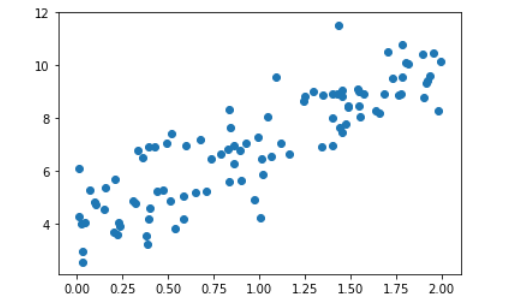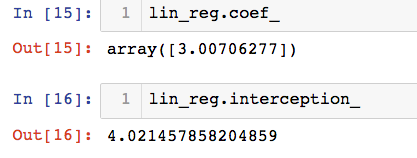梯度下降法-3.实现线性回归中的梯度下降法
实现线性回归中的梯度下降法
构造数据集
import numpy
import matplotlib.pyplot as plt
# 设置随机数种子
numpy.random.seed(666)
x = 2 * numpy.random.random(size=100)
y = x * 3. + 4. + numpy.random.normal(size=100) #random.normal 为产生正太分布的噪点
#假设此样本有一个特征值,把100个数转化为100行,1列
X = x.reshape(-1,1)

绘制此数据集:
plt.scatter(x,y)
plt.show()

使用梯度下降法训练
目标:使
\[ J = \frac{1}{m}\sum_{i=1}^{m}(y^{(i)} - \hat{y}^{(i)})^2 $$尽可能的小
$$\Lambda J = \begin{bmatrix}
\frac{\partial J}{\partial \theta _0} \\
\frac{\partial J}{\partial \theta _1} \\
\frac{\partial J}{\partial \theta _2} \\
... \\
\frac{\partial J}{\partial \theta _n}
\end{bmatrix} = \frac{2}{m}\begin{bmatrix}
\sum(X^{(i)}_b\theta - y^{(i)}) \\
\sum(X^{(i)}_b\theta - y^{(i)}) \cdot X_1^{(i)}\\
\sum(X^{(i)}_b\theta - y^{(i)}) \cdot X_2^{(i)}\\
...\\
\sum(X^{(i)}_b\theta - y^{(i)}) \cdot X_3^{(i)}
\end{bmatrix}\]
定义函数和导数的表达式
def J(theta,X_b,y): #损失函数的表达式
try:
return numpy.sum((y - X_b.dot(theta))**2)/len(X_b)
except:
return float('inf') #返回float的最大值
def dJ(theta,X_b,y): #求导
#要返回的导数矩阵
res = numpy.empty(len(theta))
res[0] = numpy.sum(X_b.dot(theta)-y)
for i in range(1,len(theta)):
res[i] = ((X_b.dot(theta)-y).dot(X_b[:,i]))
return res*2/len(X_b)
定义梯度下降的算法过程
def gradient_descent(X_b,y,init_theta,eta,n_iters=1e4,espilon=1e-8):
theta = init_theta
i_iters = 0
#n_iters 表示梯度下降的次数,超过这个值,有可能算法不收敛,退出
while n_iters>i_iters:
gradient = dJ(theta,X_b,y) #偏导数
last_theta = theta
theta = theta - eta * gradient #梯度下降,向极值移动
if abs(J(theta,X_b,y) - J(last_theta,X_b,y)) < espilon:
break
i_iters += 1
# 返回求出的theta值
return theta
构造初始参数,并进行梯度下降的过程:
X_b = numpy.hstack([numpy.ones((len(X),1)),X])
init_theta = numpy.zeros(X_b.shape[1])
eta = 0.01
theta = gradient_descent(X_b,y,init_theta,eta)
求得的theta值

创建数据集时,截距为4,斜率为3,由此可以看出,此梯度下降法成功的训练了此模型
算法的封装
def fit_gd(self,X_train,y_train,eta=0.01,n_iters=1e4):
assert X_train.shape[0] == y_train.shape[0],\
"size of x_train must be equal to the size of y_train"
def J(theta,X_b,y):
try:
return numpy.sum((y - X_b.dot(theta))**2)/len(X_b)
except:
return float('inf') # 返回float的最大值
def dJ(theta,X_b,y):
#要返回的导数矩阵
res = numpy.empty(len(theta))
res[0] = numpy.sum(X_b.dot(theta)-y)
for i in range(1,len(theta)):
res[i] = ((X_b.dot(theta)-y).dot(X_b[:,i]))
return res*2/len(X_b)
def gradient_descent(X_b,y,init_theta,eta,n_iters,espilon=1e-8):
theta = init_theta
i_iters = 0
while n_iters>i_iters:
gradient = dJ(theta,X_b,y) #偏导数
last_theta = theta
theta = theta - eta * gradient #梯度下降,向极值移动
if abs(J(theta,X_b,y) - J(last_theta,X_b,y)) < espilon:
break
i_iters += 1
return theta
X_b = numpy.hstack([numpy.ones((len(X_train),1)),X_train])
init_theta = numpy.zeros(X_b.shape[1])
self._theta = gradient_descent(X_b,y_train,init_theta,eta,n_iters)
self.coef_ = self._theta[1:] #系数
self.interception_ = self._theta[0] #截距
return self
封装后调用:
from mylib.LineRegression import LineRegression
lin_reg = LineRegression()
# 用梯度下降法训练
lin_reg.fit_gd(X,y)




